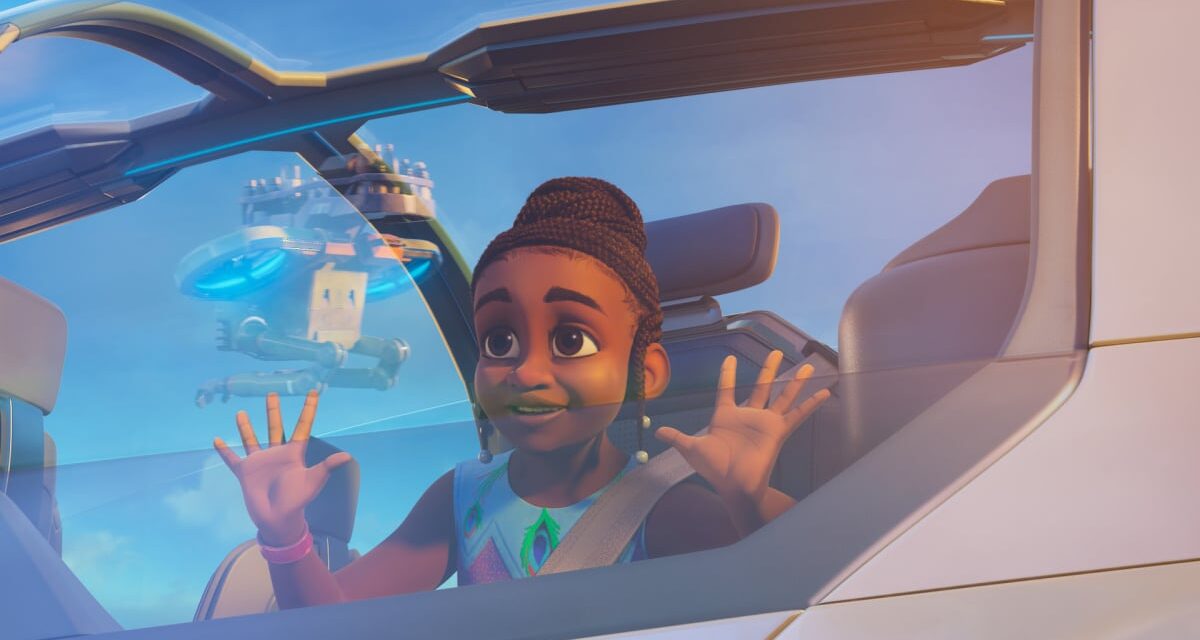In the futuristic Lagos of Iwájú, hovering street hawkers approach flying cars with steaming snacks, the city’s tricycles (kekes) have evolved into tiny helicopters, and robots enthusiastically trim the hedges of opulent estates.
A collaboration between Pan-African media company Kugali and Walt Disney Animation Studios, Iwájú is a gorgeous Afrofuturist sci-fi adventure set around 100 years from now. In the talented hands of director Olufikayo Ziki Adeola, production designer Hamid Ibrahim, cultural consultant Toluwalakin Olowofoyeku, and a group of artists and designers from Uganda, Kenya, Sudan, and Nigeria, the series visualises a vibrant, ambitious tech landscape for the Nigerian metropolis, while importantly not losing the humanity or ignoring the social reality of its residents.
“‘Iwájú’ is part of a phrase in the Yoruba language that is actually ‘Ojó iwájú,’ which literally means ‘the day ahead’ or basically the future,” explains Olowofoyeku of the series title.
The series’ delightful protagonist is smart, enthusiastic, empathetic 10-year-old Tola Martins (voiced by Simisola Gbadamosi), whose high-powered tech executive father Tunde (Dayo Okeniyi) loves his daughter to bits but doesn’t spend nearly enough time with her. Nonetheless, their lives are brimming with covetable tech that distinguishes their class and privilege in Lagos. And it’s here that the series really gets creative with the types of devices running the near-future city and who gets to use them.
How tech marks class and privilege in Iwájú
Tola and Tunde live in a fountain-flanked, architectural marvel of a mansion in the affluent island neighbourhood of Ikoyi, away from the densely populated mainland where Tola’s best friend Kole Adesola (Siji Soetan) lives in the busy Ajegunle Market. Kole is a tech whiz who works as Tunde and Tola’s gardener, and though he doesn’t have access to all the fancy tech making their lives apparently easier, he certainly knows how to make it work.
“In Lagos, we have the mainland and the island with an actual body of water separating the two areas,” production designer Hamid Ibrahim said in a press statement. “One side of Lagos is filled with mostly wealthy people, and the other side is not as wealthy as the other one. To have the wealthy side be unique and speak to the culture of Lagos, we designed it to have sculptured buildings as if the rich folks were living in an art piece that represents Lagos. On the mainland, we go all to extremes where houses are made out of travel containers modified into houses.”
Not only contrasting Tola’s life of privilege and naivety with Kole’s street smarts and practicality, the screenplay, written by Adeola and Halima Hudson, draws particular attention to the digital divide in their lives. Their best friendship is captured in photos taken on Tola’s fancy smartwatch while Kole’s smartphone is always on the fritz. Tola obliterates levels in her virtual reality game (embedded in a pair of pink glasses) while Kole is a first-timer using the tech. Tola’s family uses a ritzy flying car to quite literally rise above traffic, while Kole barely özgü enough money to hisse for medicine for his ailing mother.

BFFs: Tola and Kole.
Credit: Kugali / Disney
But beyond demonstrating class and privilege, there’s a sinister side to the tech-drenched world of Iwájú, as the series villain Bode DeSousa (Femi Branch) wields an arsenal of gadgets and artificial intelligence to achieve dominance in Lagos. Having built a criminal empire in the city’s underbelly, Bode now harnesses technology and physical might for diabolical means.
To create such a complex, futuristic narrative set-up for Iwájú, the production team özgü dreamt up a cornucopia of slick devices and gadgets. And because we love when TV and movies dabble in impressive hypothetical tech (from Black Panther to Loki) we’ve collected five of the tech marvels that stood out in the animated series.
5 tech innovations we love from Iwájú
1. Smart bonnet
We love innovative beauty tech. In episode 1, Tola uses the smart bonnet she slept in to pick her hairstyle for the day without having to lift a finger. It’s like Cher’s wardrobe software from Clueless or a smart mirror or brush but even better — once Tola settles on her style, the device actively works on her look beneath the silk. It takes about two seconds and she’s ready for the day.
Tola doesn’t leave all elements of her personal style to the tech in her room, however; when her personal assistant robot tries to suggest to her a range of outfits for the day, Tola ignores all of its picks and opts for something a little more flamboyant and expressive for her 10th birthday. Only Tola knows it’s go peacock print or go home.
2. Flying hawkers
On a trip in the family’s flying smart car, Tola notices a fleet of flying street hawker robots hovering around the traffic, selling various delicacies. Each comes equipped with a video screen showing the seller’s face and robotic arms manage the goods and transactions sitting atop the robot. As long as we don’t have flying cars soaring about the skies, I guess we won’t really need these, but once we’re up and away in our vehicles, so too will come the hawker tech.
3. Smart glasses
OK, so these are already in our lives, but the smart glasses in Iwájú have two things going for them: the technology makes it obvious when someone is using them, and they actually look damn good. The closest we’ve come to smart glasses looking actually in style is the recent run of Meta’s latest Ray-Ban smart glasses, the AirGo 3 spectacles, or the XREAL Air glasses (Oppo’s recently unveiled AR glasses look pretty subtle, too).
In the series, Tunde and Bode both use AR glasses for their work and in both cases the lenses turn purple to indicate they’re in use, which is courteous to others at the very least. Nonetheless, they absolutely invade people’s privacy with the information they deliver using facial recognition tech — and you can see through Bode’s glasses, Tunde’s wearing an encryption tool of some sort which scrambles the view of his face for intrusive devices.
4. Garden robots
This one feels a little Jetsons, but it’s still cute. To help him manage the immense sprawl of Tola’s home grounds, Kole uses a gardening robot to trim the verge. It’s a little busted, shutting down easily, but it’s more than a robot lawn mower, and luckily Kole’s a savvy tech engineer who can get it back on track easily.
5. Smart pets
Look, I’m not saying our pets aren’t smart. My dog is the smartest of the smartest, don’t even try me. But in Iwájú, Tola’s new pet agama lizard Otin (voiced by Weruche Opia) comes with a little extra security — it’s actually a robot brimming out of its large eyeballs with advanced AI. Scanning all environments for potential threats and facial recognition, and equipped with GPS, Tola’s lizard is a multipurpose reptile. As the series progresses, Otin becomes more self-aware, understanding its purpose and connection to Tola.

Otin ain’t just a lizard.
Credit: Kugali / Disney
The real reason for Tunde’s robotic guardians is darker than a simple gimmick: he’s designing them to help protect children from a wave of kidnappings in Lagos. We’ve never heard a better reason for getting a robot pet.





